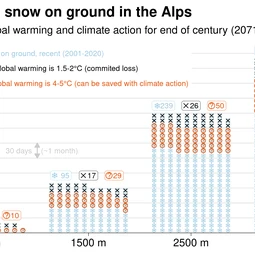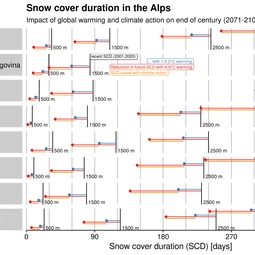Snow cover in the Alps will halve without climate action – emissions cuts can save 80% of snow days
22 June 2022
MUNICH – The number of snow cover days in the Alps could halve by the end of the century due to higher temperatures if greenhouse gas emissions remain high, having serious impacts on water availability, nature, and ski resorts, according to new research published today in the European Geosciences Union journal Hydrology and Earth Sciences.
The study found that with rapid climate action, 83% of current snow days would be saved. Without emissions cuts, however, the loss of snow would be particularly severe in the southern Alps, such as in Italy, Slovenia, and parts of France, with the south-west Alps especially badly hit. Lead author of the study Michael Matiu from Eurac Research in Italy, said, “I expected reductions in snow cover, but our findings in this paper under a strong warming scenario of 4 to 5°C are very alarming. On the other hand, there is a large margin of potential savings, if warming is limited within the Paris Agreement – which certainly raises some hope.”
This loss of snow could have serious implications for areas downstream that rely on the annual spring and summer snow melt for water. “Snow loss will lead to a temporal shift in water availability, with higher water flows in winter and less in summer. This is particularly challenging in areas which already fight for water usage,” explains Matiu.
“In any case, the Alps or the countries sharing the Alps will need to find a way to manage water availability across regions and sectors, to have enough water for agriculture, energy production, domestic use, and tourism, at the right time and in the right location.”
Martina Barandun, a glaciologist at EURAC Italy who was not involved in this study, added, “Changing snow cover patterns will affect the timing and amount of water released and affect irrigation practices. Coming from a farming background, I know the immense stress and pressure this exerts on the small farmers in mountain regions.”
The scientists found that the number of snow days lost would vary with altitude. Mountains at 2500m, for example, would lose 76 days – almost three months – worth of snow per year if emissions are high. If emissions are cut in line with the Paris Agreement, and global warming is constrained to 1.5-2°C, just 26 days – less than one month – would be lost. At 500m, snow days could be almost quartered. 14 days would be lost if emissions are high, leaving just five days of snow per year. Cutting emissions could save ten snow days.
Matiu said that while skiing would potentially be able to continue in places due to snow making machines, “skiing resorts will have to defend the high energy and water usage – especially in times of water scarcity.” But temperatures in the mountains could get too high to produce enough artificial snow before the start of the season, although the researchers did not look at this specifically.
The increased months when snow melts to reveal bare rock or grass could itself further increase
warming. White snow reflects heat, cooling the Earth, while darker rocks and vegetation absorb it,
further increasing warming. The warming temperatures in the mountains would also threaten the Alps’ iconic biodiversity, from beautiful Alpine flowers to much-loved species such as ibex and marmots. Warming the Alps will change them irrevocably – and so staying within the Paris Agreement targets is, says Matiu “most vital.”
More information
The European Geosciences Union (EGU) is Europe’s premier geosciences union, dedicated to the pursuit of excellence in the Earth, planetary, and space sciences for the benefit of humanity, worldwide. It is a non-profit interdisciplinary learned association of scientists founded in 2002 with headquarters in Munich, Germany. The EGU publishes a number of diverse scientific journals that use an innovative open access format and organises topical meetings plus education and outreach activities. Its annual General Assembly is the largest and most prominent European geosciences event, attracting more than 14,000 scientists from all over the world. The meeting’s sessions cover a wide range of topics, including volcanology, planetary exploration, the Earth’s internal structure and atmosphere, climate, energy, and resources. For more information, follow the EGU on Twitter and Facebook.
If you wish to receive our press releases via email, please use the Press Release Subscription Form at https://www.egu.eu/news/subscribe/. Subscribed journalists and other members of the media receive EGU press releases under embargo (if applicable) 24 hours in advance of public dissemination.
Contact
Gillian D’Souza
Media and Communications Officer
European Geosciences Union
Munich, Germany
Email media@egu.eu


